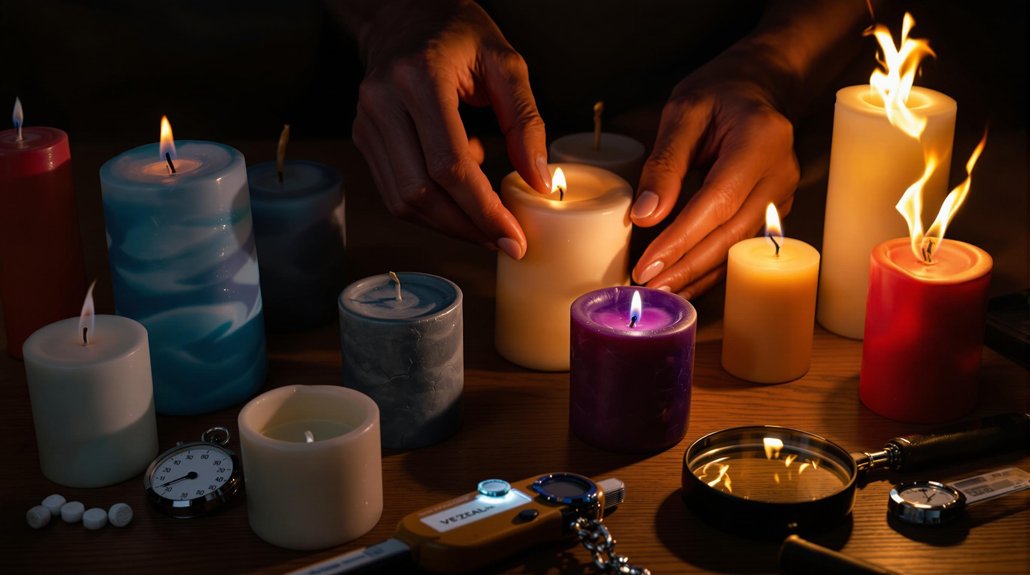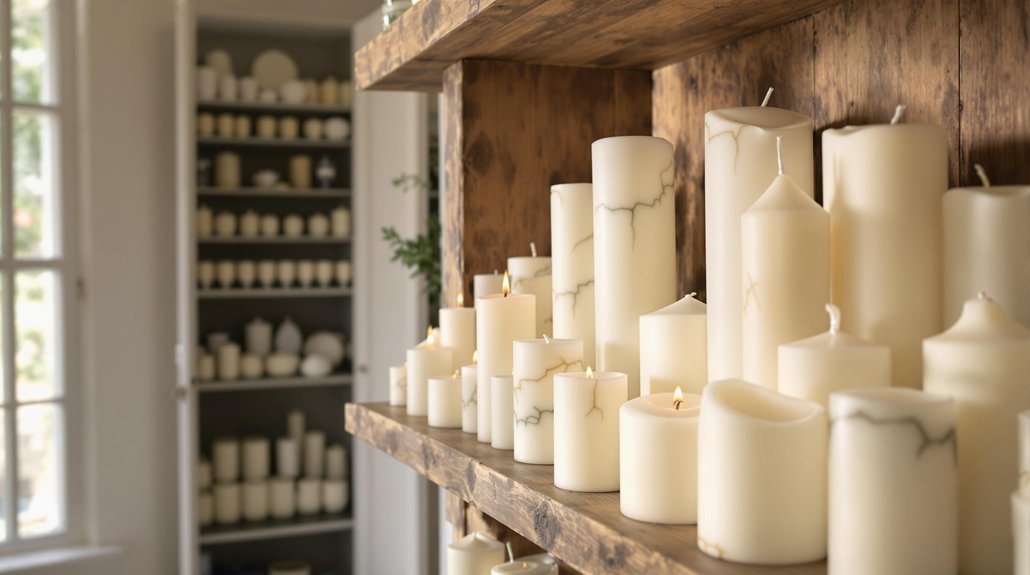Do Candles Expire? How to Tell If Yours Are Still Good

You’ve just found an old candle tucked away in a drawer—maybe it’s a favorite scent, maybe it’s never been lit. But now you’re wondering: Do candles expire? While they don’t have a strict shelf life like food, candles can degrade over time.
Changes in scent, appearance, and performance are all signs that your candle might not burn like it used to. In this article, we’ll break down how long different types of candles typically last, what affects their longevity, and how to tell if yours are still good to use.
Signs Your Candle Is Past Its Prime
Even though candles don’t come with an expiration date, they can lose their quality over time. If you’re unsure whether that old candle is still good to use, here are some easy-to-spot signs that it might be past its prime:
1. Faded or Weak Scent
One of the first things you’ll notice is a much weaker fragrance. Over time, especially if the candle has been exposed to air or heat, the scent oils can evaporate. If your candle barely smells anymore—or not at all—it’s a sign the fragrance has broken down.
2. Wax "Sweating"
If you see small beads or oily spots forming on the surface of the candle, it’s likely “sweating.” This can happen when candles are stored in hot or humid conditions. While not always harmful, it may affect both the scent and the way the candle burns.
3. Discoloration
A slight color change over time is normal, especially in scented or dyed candles. However, if the candle looks blotchy, faded, or dramatically different from its original color, it’s likely been affected by light, heat, or age—often a sign of degraded ingredients.
4. Crumbly or Dry Texture
Touch the wax—if it feels brittle, crumbly, or dried out, that’s a red flag. Dried-out wax can burn unevenly, tunnel, or fail to stay lit. It’s also a sign that the candle may have been exposed to air or improper storage for too long.
5. Damaged or Degraded Wick
Inspect the wick closely. If it looks frayed, bent, brittle, or unusually stiff, it might not burn properly—or safely. A poor-quality wick can lead to flickering, uneven burns, or even smoke and soot issues.
If your candle shows one or more of these signs, it doesn’t necessarily mean you have to toss it—but you may want to burn it with caution, or repurpose it for a craft or décor project instead. Safe handling of candles is crucial to prevent accidents, especially when the candle shows signs of wear and tear.
Understanding Candle Expiration
Candles don’t have a set expiration date like food or medicine, but they can definitely lose their quality over time. This is especially true for scented candles, which are more sensitive to changes in storage conditions and air exposure.
On average, most candles—especially scented ones—have a lifespan of about 2 to 4 years. After that, their fragrance may fade, and the wax or wick might not perform as well. That said, if you store your candles properly (cool, dry place away from direct sunlight), many can last much longer without noticeable decline.
Several factors influence how long a candle stays in good condition:
Wax Type: Soy and natural waxes tend to degrade faster than paraffin-based ones.
Fragrance Strength: Heavily scented candles may lose their scent more quickly, especially if stored in open air.
Storage Conditions: Heat, humidity, and direct light can all break down fragrance oils and wax consistency.
If you’re not sure whether a candle has expired, check for these common signs:
Weakened or no scent throw
Sweating wax (small beads of oil on the surface)
Discoloration or fading
Crumbly or dry wax texture
Damaged or brittle wick
While burning an expired candle is generally safe, it might not perform well. If the wick seems weak or the candle smells “off,” it’s better to be safe and toss it—or consider repurposing it as wax melts or décor. To maximize lifespan and performance, implement proper candle care and storage practices.
Evaluating Candle Safety and Performance

When assessing whether a candle is still safe and effective to use, start by checking the condition of the wick and wax.
Wick Issues: If the wick appears frayed, brittle, or won’t stay lit, it may be damaged or too old to function properly. A compromised wick can lead to uneven burning, excessive smoke, or even safety risks.
Wax Discoloration: Notice any significant color changes? This could be a result of UV light exposure or age. While slight fading is normal, dramatic discoloration may indicate that the candle’s materials have started to break down.
Uneven Burning: A candle that burns unevenly or tunnels is often past its prime. This could be due to wax degradation or fragrance oil separation over time.
Off Smell: If your candle smells more waxy than fragrant, it’s a sign that the fragrance oils have faded or turned, especially if the candle was stored improperly.
Weakened Scent: A weak or barely noticeable scent usually means the fragrance oils have lost their potency, reducing the overall experience and effectiveness of the candle.
Candles can last for years if stored correctly, but if you notice any of these red flags, it may be time to retire the candle or repurpose it for non-burning use. For emergency situations, long burn times and stable flames are crucial factors to consider when choosing suitable candles.
Tips for Extending Candle Lifespan
Want your candles to last longer and burn better? A few simple habits can go a long way in preserving their quality, scent, and safety.
1. Store Candles Properly
Keep your candles in a cool, dry place away from direct sunlight. Heat and light can break down fragrance oils and fade colors over time. Proper storage helps preserve the scent and ensures the wax stays stable and safe to burn.
2. Trim the Wick Before Every Burn
Always trim the wick to about 1/4 inch before lighting. This helps promote an even, steady flame, reduces soot, and prevents the wick from mushrooming—extending the life of your candle and improving its performance.
3. Avoid Overburning
Limit each burn session to around 2 to 4 hours. Let the wax melt evenly across the entire surface before extinguishing. This prevents tunneling (where the wax burns down the center) and helps your candle last longer.
4. Cover Between Uses
When the candle isn’t in use, seal it with a lid or store it in an airtight container. This helps lock in the fragrance and keeps out dust or debris that could affect the burn.
5. Watch for Signs of Aging
Check your candles occasionally for signs of wear—like a weak scent, discoloration, or wax sweating. Catching these early helps you decide whether to use, repurpose, or retire the candle.
With just a little care, you can get the most out of your candles—preserving their beauty, scent, and safety for years to come.
Candle Storage Best Practices

Storing your candles the right way is essential to preserving their scent, appearance, and performance over time. With just a few simple steps, you can keep them in top condition for whenever you're ready to light them.
1. Keep Them Cool and Dark
Store candles in a cool, dry, and dark place to prevent heat and sunlight from degrading the wax or fading the fragrance. Excessive heat can cause softening, warping, or sweating on the candle’s surface.
2. Store Upright
Beeswax candles and long, tapered candles should always be stored upright. This helps prevent bending, warping, or wick damage, which can affect how they burn later on.
3. Use Airtight Containers
For long-term storage, place candles in airtight containers or wrap them in protective materials to block out moisture and unwanted odors. This also helps preserve their original scent and prevents contamination from surrounding items.
4. Inspect Periodically
Check stored candles occasionally for signs of discoloration, crumbling, or odd smells. These are signs they may have passed their prime and won’t perform as expected.
5. Avoid Drafty Areas
Even in storage, drafty areas can affect your candles. Airflow may carry dust or other particles that settle on the wax or wick, impacting future burns and scent quality.
By following these simple storage tips, you’ll help ensure your candles stay fresh, fragrant, and ready to burn safely whenever you need them.




